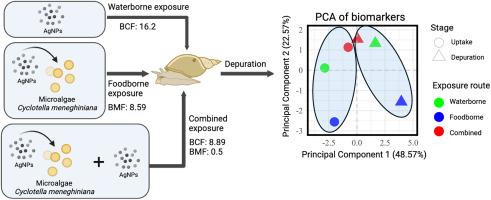从微藻到腹足类:了解银纳米颗粒在淡水水生环境中的动力学和毒性
IF 7.3
2区 环境科学与生态学
Q1 ENVIRONMENTAL SCIENCES
引用次数: 0
摘要
银纳米粒子(AgNPs)越来越多地用于各种消费品和工业应用,引起了人们对其对水生生态系统环境影响的关注。本研究研究了柠檬酸盐包覆AgNPs在淡水食物链中的物理化学稳定性、营养转移和毒性作用,包括硅藻meneghiniana Cyclotella和腹足动物lynaea滞生。AgNPs在暴露介质中保持稳定,24 h后溶解最小(<0.06%),表明暴露期间颗粒形式占主导地位。AgNPs抑制了meneghiniana的生长,但对叶绿素-a含量和活性氧(ROS)的产生没有显著影响。扫描电镜显示细胞外聚合物(EPS)分泌,可能形成生态冠状,降低AgNPs的生物利用度和氧化损伤。然而,微量元素分析显示铁、锰和镍的显著耗竭,表明早期代谢应激和必需金属的重新分配以支持抗氧化防御。毒动力学分析表明,在不同的暴露途径中,银的吸收和净化模式不同。与联合组相比,水和食源性暴露导致的银积累相似且更高。水接触显示出最高的不可消除分数和生物浓度因子(BCF) >;1,表明有效的吸收和保留。食源性暴露表现出生物放大因子(BMF) >;1、尽管高效淘汰。综合暴露的净化率最高,BCF >;1和BMF <;1,反映了营养转移电位的降低。在联合暴露期间,停滞乳杆菌的氧化应激最高,在摄取期间血淋巴中的ROS增加。食源性暴露造成长期免疫应激,总抗氧化能力(TAC)和蛋白质水平升高就是证据。在肝胰腺中,净化过程中的食源性暴露导致脂质过氧化和TAC增加,表明饮食暴露特有的氧化和代谢挑战。这些结果强调了淡水生态系统中AgNPs与初级生产者和消费者的复杂相互作用,强调了在纳米颗粒风险评估中进行多途径评估的必要性。本文章由计算机程序翻译,如有差异,请以英文原文为准。


From microalgae to gastropods: Understanding the kinetics and toxicity of silver nanoparticles in freshwater aquatic environment
Silver nanoparticles (AgNPs) are increasingly used in various consumer products and industrial applications, raising concerns about their environmental impact on aquatic ecosystems. This study investigated the physicochemical stability, trophic transfer, and toxic effects of citrate-coated AgNPs in a freshwater food chain including the diatom Cyclotella meneghiniana and the gastropod Lymnaea stagnalis. AgNPs remained stable in the exposure medium, with a minimal dissolution (<0.06%) after 24 h, indicating that particulate forms dominated during exposure. AgNPs inhibited the growth of C. meneghiniana without significantly affecting chlorophyll-a content or reactive oxygen species (ROS) production. Scanning electron microscopy revealed extracellular polymeric substance (EPS) secretion, which likely formed eco-coronas, reducing AgNPs bioavailability and oxidative damage. However, trace element analysis showed significant depletion of iron, manganese, and nickel, indicating early metabolic stress and redistribution of essential metals to support antioxidant defenses. In L. stagnalis, toxicokinetic analysis showed distinct patterns of Ag uptake and depuration across exposure routes. Waterborne and foodborne exposure resulted in similar and higher Ag accumulation compared to the combined group. Waterborne exposure showed the highest non-eliminable fraction and a bioconcentration factor (BCF) > 1, indicating efficient uptake and retention. Foodborne exposure exhibited a biomagnification factor (BMF) > 1, despite efficient elimination. Combined exposure had the highest depuration rate, with BCF >1 and BMF <1, reflecting reduced trophic transfer potential. Oxidative stress in L. stagnalis was highest during combined exposure, with increased ROS in hemolymph during uptake. Foodborne exposure caused prolonged immune stress, evidenced by elevated total antioxidant capacity (TAC) and protein levels. In the hepatopancreas, foodborne exposure during depuration led to increased lipid peroxidation and TAC, indicating oxidative and metabolic challenges specific to dietary exposure. These results highlighted the complex interactions of AgNPs with primary producers and consumers in freshwater ecosystems, emphasizing the need for multi-route assessments in nanoparticle risk evaluations.
求助全文
通过发布文献求助,成功后即可免费获取论文全文。
去求助
来源期刊

Environmental Pollution
环境科学-环境科学
CiteScore
16.00
自引率
6.70%
发文量
2082
审稿时长
2.9 months
期刊介绍:
Environmental Pollution is an international peer-reviewed journal that publishes high-quality research papers and review articles covering all aspects of environmental pollution and its impacts on ecosystems and human health.
Subject areas include, but are not limited to:
• Sources and occurrences of pollutants that are clearly defined and measured in environmental compartments, food and food-related items, and human bodies;
• Interlinks between contaminant exposure and biological, ecological, and human health effects, including those of climate change;
• Contaminants of emerging concerns (including but not limited to antibiotic resistant microorganisms or genes, microplastics/nanoplastics, electronic wastes, light, and noise) and/or their biological, ecological, or human health effects;
• Laboratory and field studies on the remediation/mitigation of environmental pollution via new techniques and with clear links to biological, ecological, or human health effects;
• Modeling of pollution processes, patterns, or trends that is of clear environmental and/or human health interest;
• New techniques that measure and examine environmental occurrences, transport, behavior, and effects of pollutants within the environment or the laboratory, provided that they can be clearly used to address problems within regional or global environmental compartments.
 求助内容:
求助内容: 应助结果提醒方式:
应助结果提醒方式:


